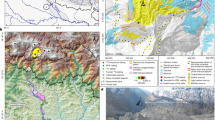Abstract
THE severely degraded landscape of the volcanic highlands of central Mexico has been the focus of considerable debate1–5. Although it is widely believed that the Spanish encountered an almost pristine landscape in AD 1521 (refs 1–3), some archival and palaeolimnological studies have suggested that extensive land clearance began before European contact, during the Preclassic to Postclassic periods (˜3,500–350 14C yr before present, BP) 5–11. Here we analyse sediment cores from Lake Pátzcuaro, Michoacán (Fig. 1), to derive a quantitative estimate of variations in soil erosion in central Mexico since 4,000 yr BP. We identify three periods of accelerated erosion and conclude that erosion rates during both the late Preclassic/early Classic periods (2,500–1,200 yr BP) and the later Postclassic period (850–350 yr BP) were at least as high as those after the Spanish conquest. One implication of these results is that soil erosion caused by the Spanish introduction of plough agriculture was apparently no more severe than that associated with traditional agricultural methods; it is therefore questionable whether a return to traditional methods would have significant environmental benefits.
This is a preview of subscription content, access via your institution
Access options
Subscribe to this journal
Receive 51 print issues and online access
$199.00 per year
only $3.90 per issue
Buy this article
- Purchase on Springer Link
- Instant access to full article PDF
Prices may be subject to local taxes which are calculated during checkout
Similar content being viewed by others
References
Chevalier, F. Land and Society in Colonial México: The Great Hacienda (Univ. of California Press, Berkeley, 1963).
Helms, M. W. Middle America: A Cultural History of Heartland and Frontiers (Prentice-Hall, Englewood Cliffs, 1975).
Melville, E. G. K. Compar. Stud. Soc. Hist. 32, 24–53 (1990).
Denevan, W. M. Ann. Assoc. Am. Geogr. 82, 369–385 (1992).
Butzer, K. W. and Butzer, E. K. in Culture, Form and Place (ed. Mathewson, K.) (Louisiana State Univ., in the press).
Watts, W. A. & Bradbury, J. P. Quat Res. 17, 56–70 (1982).
Brown, R. B. in Pollen Records of Late Quaternary North American Sediments (eds Bryant, V. M. & Holloway, R. G.) 71–93 (Am. Assoc. stratigr. Palynol., Dallas, 1985).
Metcalfe, S. E. thesis, Oxford Univ. (1985).
Steininger, F. M. thesis, Oxford Univ. (1988).
Metcalfe, S. E. et al. Geoarchaeology 4, 191–141 (1989).
Street-Perrott, F. A., Perrott, R. A. & Harkness, D. D. Am. Antiq. 54, 759–765 (1989).
Chacon Torres, A. thesis, Stirling Univ. (1989).
Bradbury, J. P. Limnol. Oceanogr. 16, 180–200 (1971).
Metcalfe, S. E. et al. J. Paleolimnol. 5, 197–218 (1991).
O'Hara, S. L. thesis, Oxford Univ. (1991).
Metcalfe, S. E. et al. in Effects of Environmental Change in Drylands (eds Mitlington, A. C. & Pye, K.) (J. Wiley, London, in the press).
Gorenstein, S. and Pollard, H. P. The Tarascan Civilization: A Late Prehispanic Cultural System (Publ. Anthropol. 28, Vanderbilt Univ., Nashville, 1983).
Pollard, H. P. thesis, Columbia Univ. (1972).
Relacion de Michoacȧn 1541. Relación de las Ceremonias y Ritos y Problación y Gobierno de Michoacán. Reproducción facsimilar del MS. Ç. IV.5. de El Escorial (Aguilar, Madrid, 1956).
Porter, M. Am. philos. Soc. Trans. 46, Part 5 (1956).
Sanders, W. T., Parsons, J. R. & Santley, R. S. The Basin of México: Ecological Process in the Evolution of a Civilization (Academic, New York, 1976).
Doolittle, W. E. Canal Irrigation in Prehispanic México: The Sequence of Technological Change (Univ. of Texas Press, Austin, 1990).
Archivo General de la Nación, México Tierràs, Vol. 64, Exped. 3.
van der Plicht, J. & Mook, W. G. Radiocarbon 31, 805–816 (1989).
Deevey, E. S. et al. Science 206, 298–306 (1979).
Binford, M. W. et al. Quat Sci. Rev. 6, 115–128 (1987).
Gillieson et al. in International Geomorphology. 1986. Part II. (ed. Gardner, V.) 507–522 (J. Wiley, London, 1986).
Shaw, E. M. Hydrology in Practice (Van Nostrand Reinhold, New York, 1983).
Engstrom, D. & Wright, H. E. in Lake Sediments and Environmental History (eds Haworth, E. Y. & Lund, J. W. G.) 11–67 (Leicester Univ. Press, 1984).
Walling, D. E. & Quine, T. A. in Soil Erosion and Agricultural Land (eds Boardman, J., Foster, I. D. L. & Dearing, J. A.) 33–54 (Wiley, London, 1990).
Author information
Authors and Affiliations
Rights and permissions
About this article
Cite this article
O'Hara, S., Street-Perrott, F. & Burt, T. Accelerated soil erosion around a Mexican highland lake caused by prehispanic agriculture. Nature 362, 48–51 (1993). https://doi.org/10.1038/362048a0
Received:
Accepted:
Published:
Issue Date:
DOI: https://doi.org/10.1038/362048a0
This article is cited by
-
Historical Pollution of an Urban Watershed Based in Geochemical, Geoacumulation, and EROD Activity in PLHC-1 Analyses in Sediment Cores
Archives of Environmental Contamination and Toxicology (2019)
-
Long-term responses of mountain forests to environmental change in West-Central Mexico
Regional Environmental Change (2019)
-
Geology and radiometric dating of Quaternary monogenetic volcanism in the western Zacapu lacustrine basin (Michoacán, México): implications for archeology and future hazard evaluations
Bulletin of Volcanology (2018)
-
Effects of slope gradient on runoff from bare-fallow purple soil in China under natural rainfall conditions
Journal of Mountain Science (2018)
-
Re-Envisioning Tarascan Temporalities and Landscapes: Historical Being, Archaeological Representation, and Futurity in Past Social Processes
Journal of Archaeological Method and Theory (2017)
Comments
By submitting a comment you agree to abide by our Terms and Community Guidelines. If you find something abusive or that does not comply with our terms or guidelines please flag it as inappropriate.



